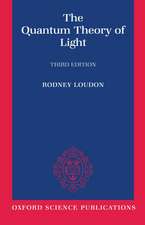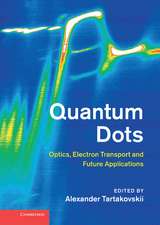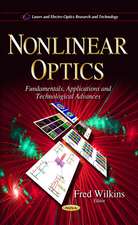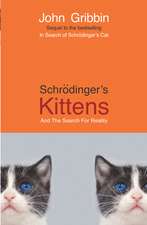Interpretation of Classical Electromagnetism: Fundamental Theories of Physics, cartea 78
Autor G. Rosseren Limba Engleză Hardback – 31 mai 1997
| Toate formatele și edițiile | Preț | Express |
|---|---|---|
| Paperback (1) | 1822.89 lei 6-8 săpt. | |
| SPRINGER NETHERLANDS – 5 dec 2010 | 1822.89 lei 6-8 săpt. | |
| Hardback (1) | 1829.36 lei 6-8 săpt. | |
| SPRINGER NETHERLANDS – 31 mai 1997 | 1829.36 lei 6-8 săpt. |
Din seria Fundamental Theories of Physics
- 20%
 Preț: 1002.39 lei
Preț: 1002.39 lei -
 Preț: 426.56 lei
Preț: 426.56 lei - 20%
 Preț: 819.51 lei
Preț: 819.51 lei - 18%
 Preț: 779.26 lei
Preț: 779.26 lei - 18%
 Preț: 955.25 lei
Preț: 955.25 lei - 18%
 Preț: 950.52 lei
Preț: 950.52 lei - 24%
 Preț: 794.91 lei
Preț: 794.91 lei - 18%
 Preț: 948.47 lei
Preț: 948.47 lei - 15%
 Preț: 589.80 lei
Preț: 589.80 lei - 18%
 Preț: 1229.73 lei
Preț: 1229.73 lei - 15%
 Preț: 587.83 lei
Preț: 587.83 lei - 18%
 Preț: 1236.06 lei
Preț: 1236.06 lei - 18%
 Preț: 946.87 lei
Preț: 946.87 lei -
 Preț: 394.87 lei
Preț: 394.87 lei - 18%
 Preț: 954.93 lei
Preț: 954.93 lei - 18%
 Preț: 1241.10 lei
Preț: 1241.10 lei - 18%
 Preț: 954.93 lei
Preț: 954.93 lei - 18%
 Preț: 953.35 lei
Preț: 953.35 lei - 18%
 Preț: 948.92 lei
Preț: 948.92 lei - 15%
 Preț: 648.05 lei
Preț: 648.05 lei - 18%
 Preț: 1232.09 lei
Preț: 1232.09 lei - 18%
 Preț: 996.78 lei
Preț: 996.78 lei - 18%
 Preț: 946.41 lei
Preț: 946.41 lei - 15%
 Preț: 640.24 lei
Preț: 640.24 lei - 15%
 Preț: 636.80 lei
Preț: 636.80 lei -
 Preț: 391.79 lei
Preț: 391.79 lei - 18%
 Preț: 780.19 lei
Preț: 780.19 lei -
 Preț: 391.79 lei
Preț: 391.79 lei - 15%
 Preț: 649.06 lei
Preț: 649.06 lei -
 Preț: 397.76 lei
Preț: 397.76 lei - 24%
 Preț: 586.71 lei
Preț: 586.71 lei - 15%
 Preț: 644.95 lei
Preț: 644.95 lei - 18%
 Preț: 1228.15 lei
Preț: 1228.15 lei
Preț: 1829.36 lei
Preț vechi: 2230.94 lei
-18% Nou
Puncte Express: 2744
Preț estimativ în valută:
350.03€ • 365.50$ • 289.05£
350.03€ • 365.50$ • 289.05£
Carte tipărită la comandă
Livrare economică 15-29 aprilie
Preluare comenzi: 021 569.72.76
Specificații
ISBN-13: 9780792341871
ISBN-10: 0792341872
Pagini: 426
Ilustrații: XVIII, 426 p.
Dimensiuni: 155 x 235 x 25 mm
Greutate: 0.81 kg
Ediția:1997
Editura: SPRINGER NETHERLANDS
Colecția Springer
Seria Fundamental Theories of Physics
Locul publicării:Dordrecht, Netherlands
ISBN-10: 0792341872
Pagini: 426
Ilustrații: XVIII, 426 p.
Dimensiuni: 155 x 235 x 25 mm
Greutate: 0.81 kg
Ediția:1997
Editura: SPRINGER NETHERLANDS
Colecția Springer
Seria Fundamental Theories of Physics
Locul publicării:Dordrecht, Netherlands
Public țintă
ResearchCuprins
1. A Typical Conventional Development of Maxwell’s Equations.- 2. The Scalar Potential ? and the Vector Potential A.- 3. The Electric and Magnetic Fields due to an Accelerating Classical Point Charge.- 4. Development of Maxwell’s Equations from the Expressions for the Electric and Magnetic Fields due to a Moving Classical Point Charge.- 5. Electric Fields due to Electrical Circuits.- 6. Magnetic Fields due to Electrical Circuits.- 7. Quasi-Stationary Phenomena and AC Theory.- 8. Forces, Energy and Electromagnetic Momentum.- 9. Stationary Dielectrics and Stationary Magnetic Materials.- 10. Special Relativity and Classical Electromagnetism.- Appendix A. Mathematical Methods.- A1. A summary of the formulae of vector analysis.- A1.1. Scalar and vector products.- A1.2. The gradient of a scalar.- A1.3. The divergence of a vector.- A1.4. The curl of a vector.- A1.5. The Laplacian operator.- A1.6. Some useful relations.- A1.7. Gauss’ mathematical theorem.- A1.8. Stokes’ theorem.- A1.9. Cylindrical coordinates.- A1.10. Spherical polar coordinates.- A2. The partial derivatives of macroscopic field variables.- A3. Some useful mathematical relations.- A4. The corrections to the differential form of the Biot-Savart law for steady currents.- Appendix B. Conduction Current Flow in Stationary Conductors.- B 1. Example of the mode of action of a source of emf.- B2. Location of the charge distributions associated with conduction current flow.- B3. Magnitudes of the surface and boundary charge distributions associated with conduction current flow.- B4. Models of conduction current flow in a stationary conductor.- B5. Energy propagation in DC circuits.- Appendix C. The Electric and Magnetic Fields due to an Accelerating Classical Point Charge.- Cl. Introduction.- C2. Calculationof the electric field.- C3. Calculation of the magnetic field.- Appendix E. The Transformations of Special. Relativity.
















